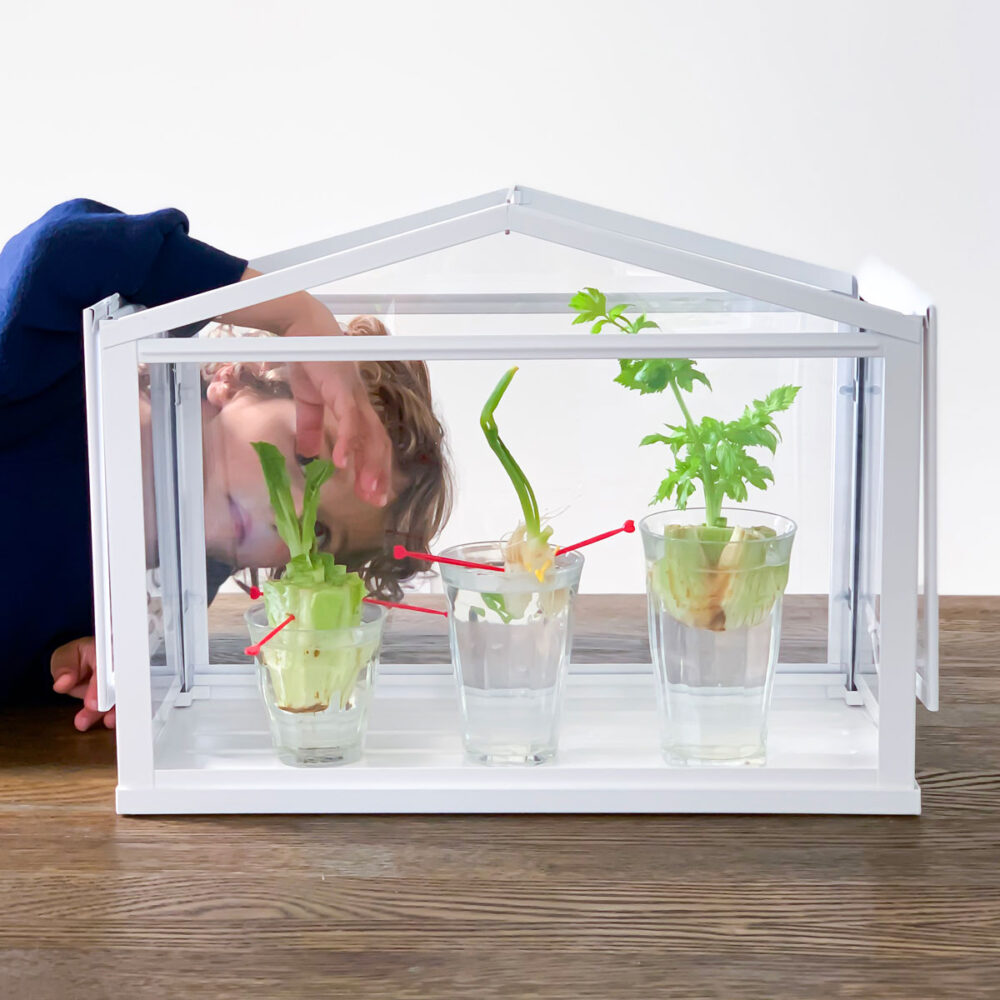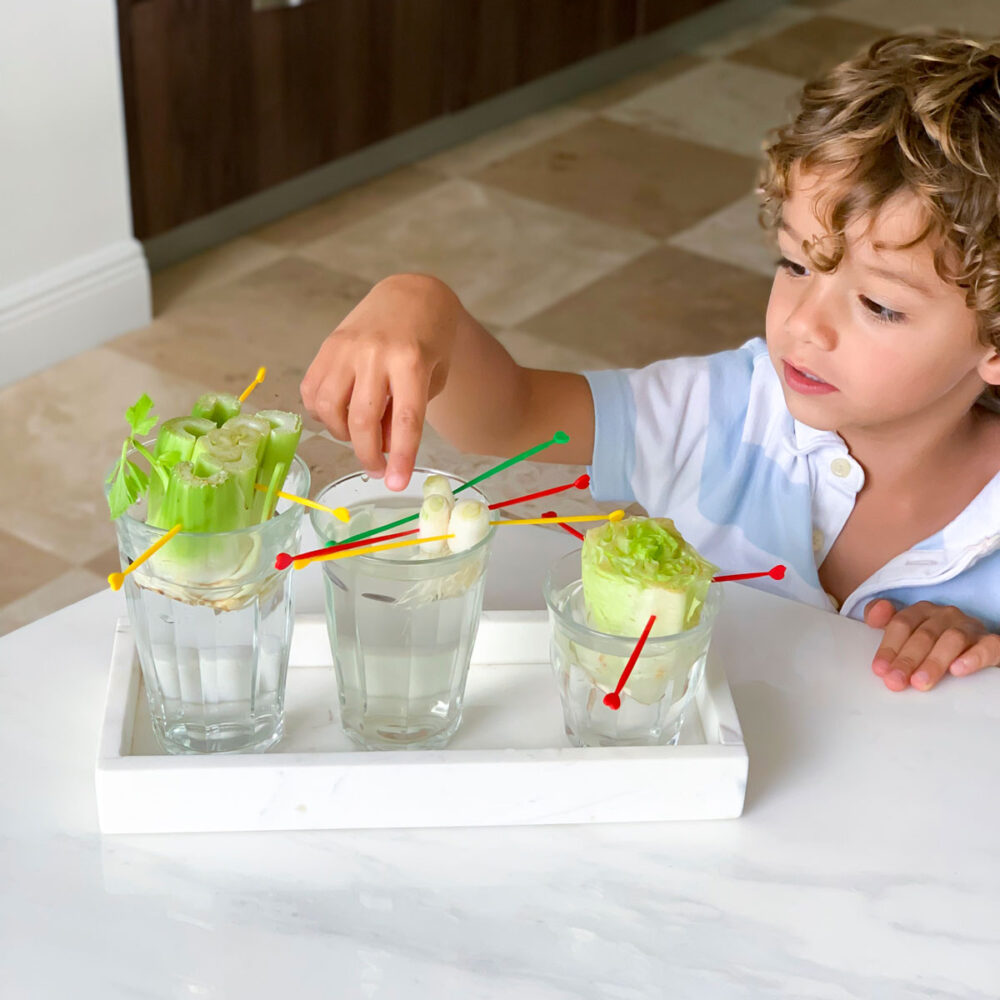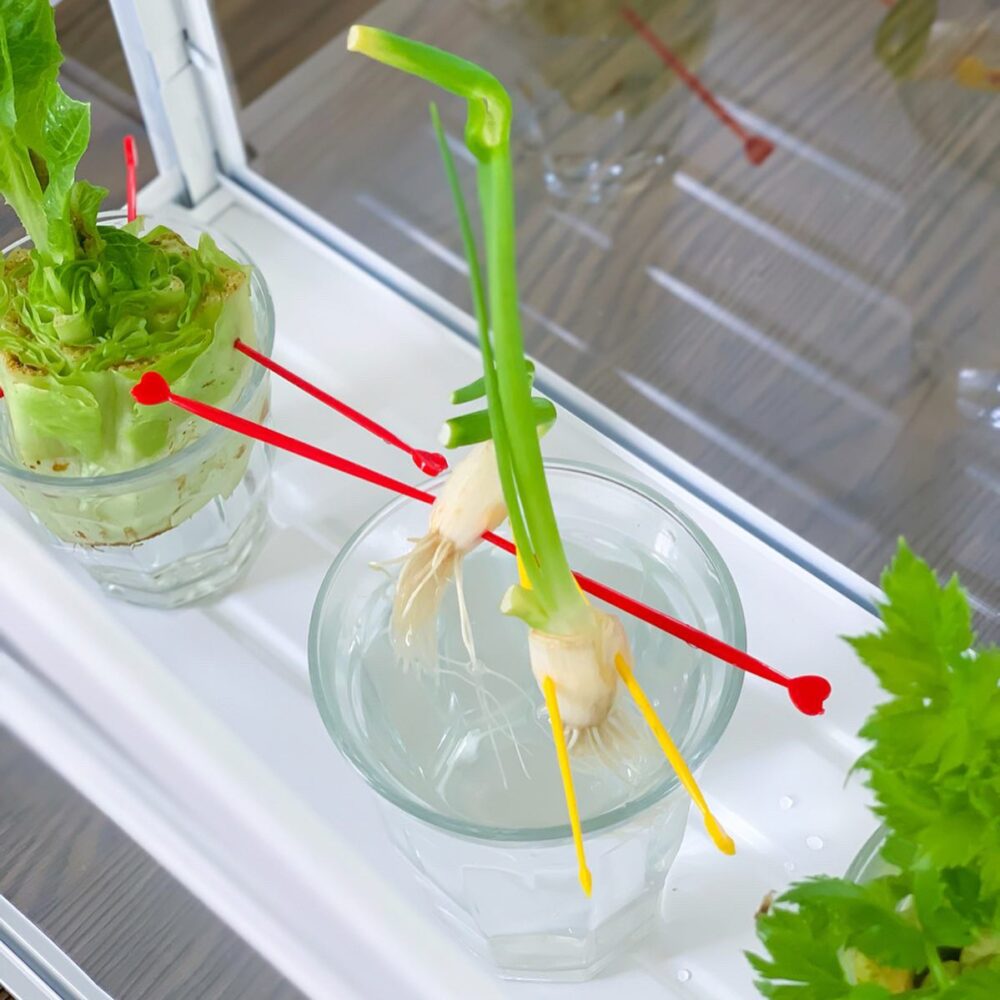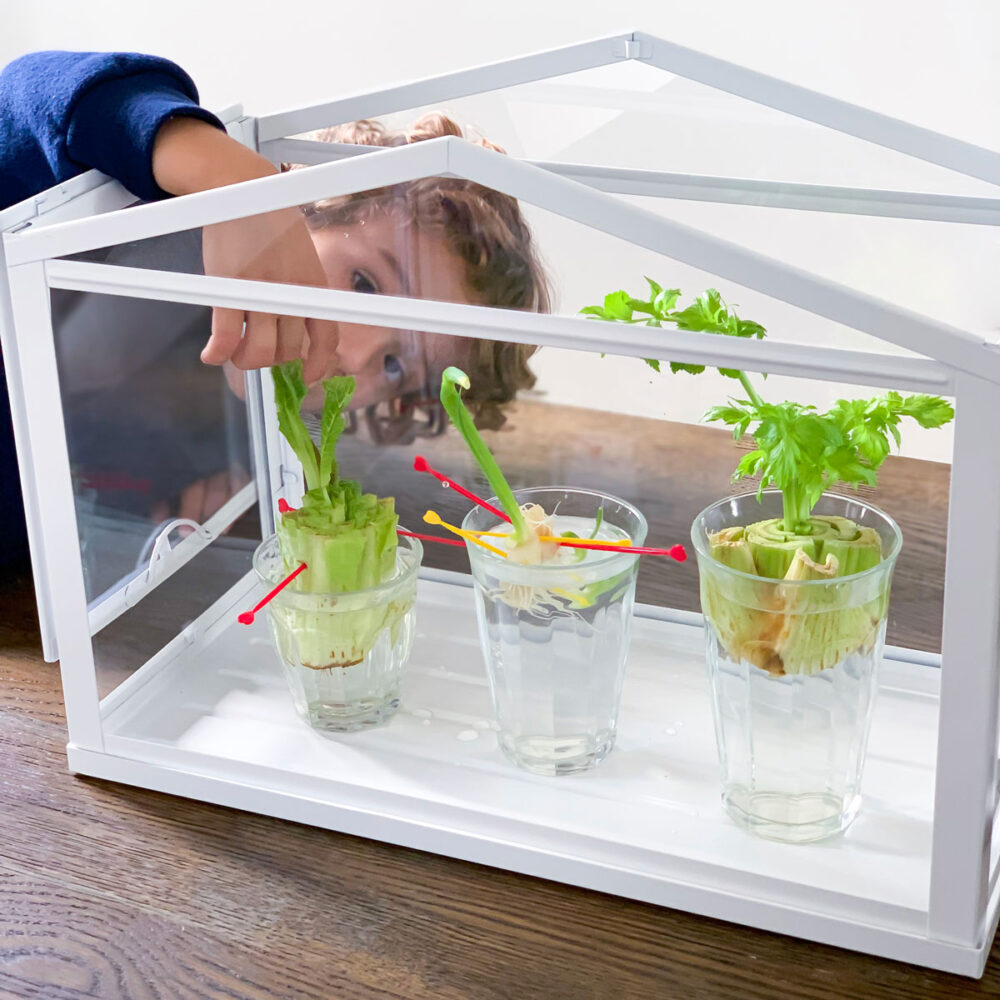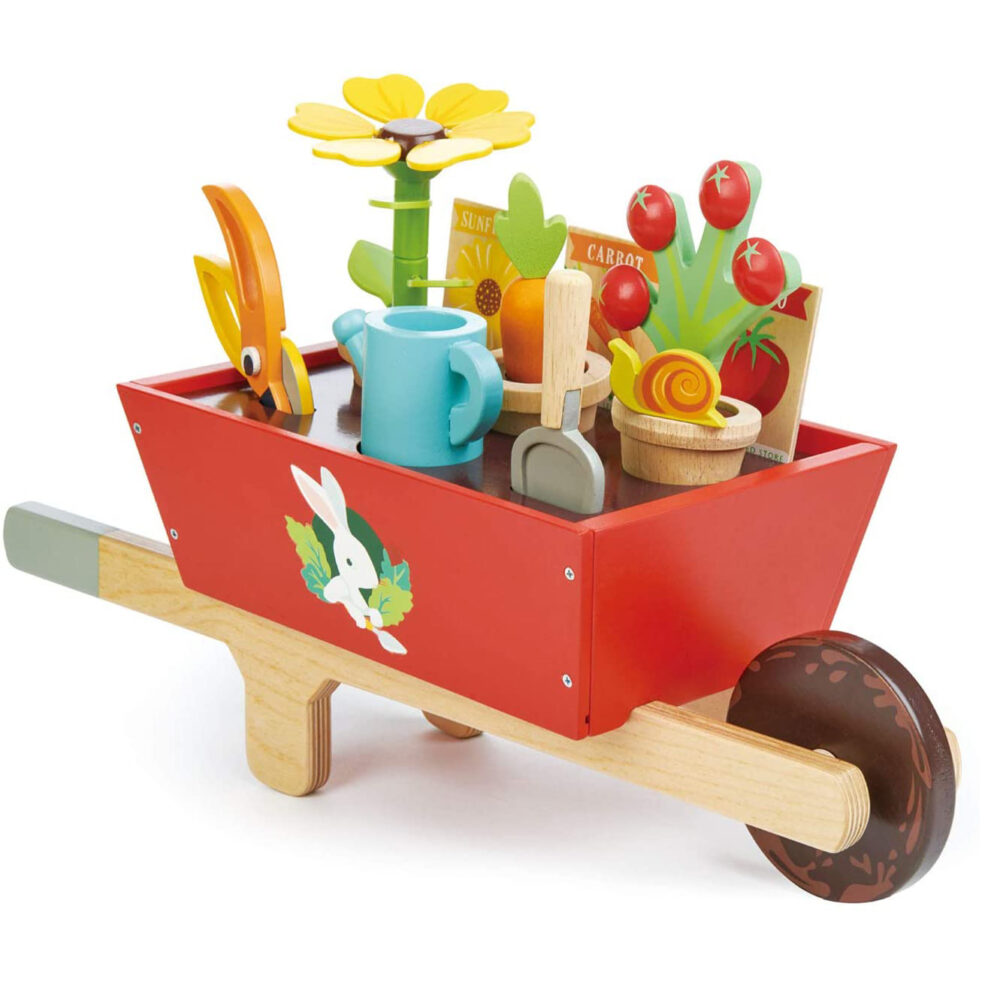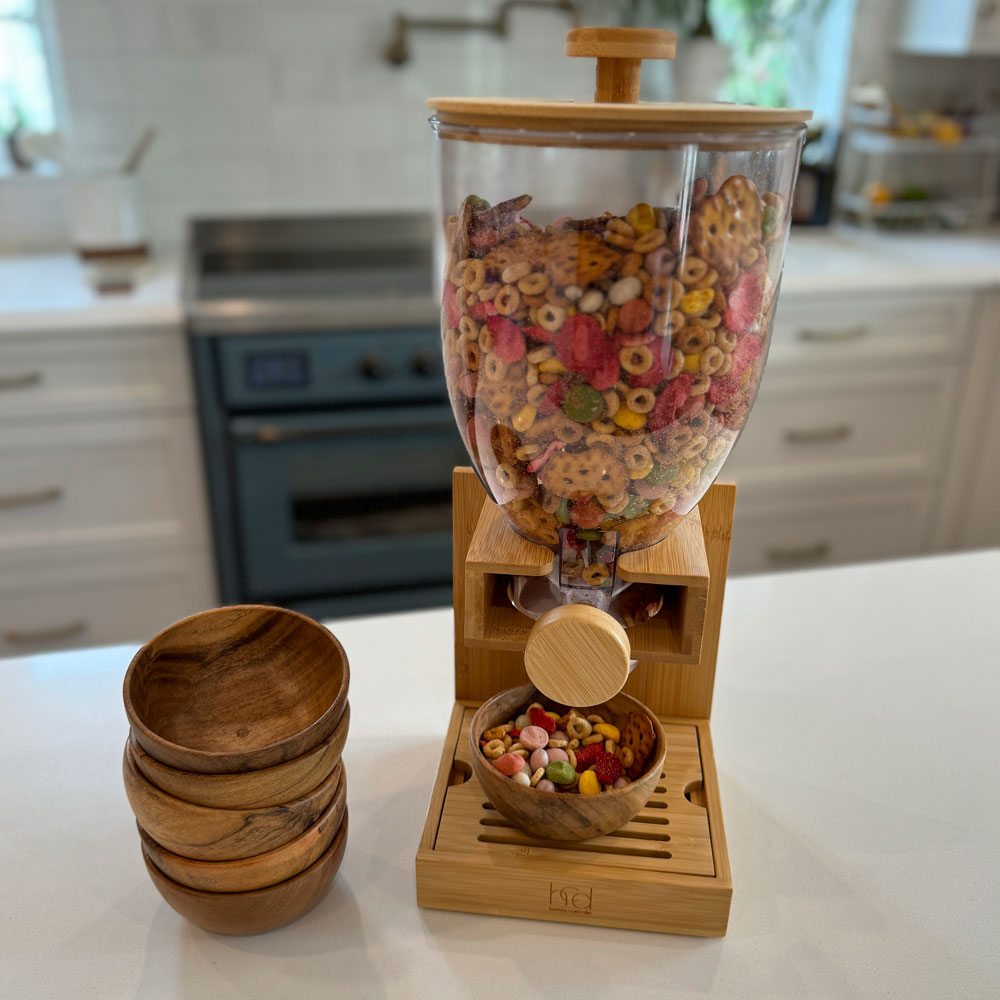Science Experiment with Food – Regrowing Food Scraps
Observing how vegetables regrow from scraps is a fun science experiment with food for kids to do at home or beyond with no yard required! My kids love watching vegetables regrow from the windowsill, and if you have the yard space, you could even start a little garden with your kids!
You can teach your little ones about how they can turn garbage into food that you can eat! Which is pretty cool if you ask me!
Learn About Your Food and Where it Comes From
Teach your children about plants’ life cycle, basic gardening skills, and even the scientific method with regrowing food scraps. This easy DIY food scrap garden activity is a fun way for your kids to practice hands-on science and learn.
Plus, even parents can get in on the fun and save a little bit of money on your next trip to the grocery store too!
Teach Science with Regrowing Food Scraps
We saved the bottoms of celery, green onions, and romaine lettuce to regrow our own vegetables. All you have to do is plop them into some water and make sure they get plenty of sun! Two weeks later and we had an entirely grown vegetable ready to eat!
Using a plant’s ability to grow new roots is a great way to study plants and help you save money on food and reduce your food waste.
All activities should be supervised by an adult. As an Amazon Associate I earn from qualifying purchases. This post may contain affiliate links.
A Science Experiment with Food That Reduces Waste
We saved the bottoms of celery, green onions, and romaine lettuce to regrow our own vegetables. All you have to do is plop them into some water and make sure they get plenty of sun! Two weeks later and we had an entirely grown vegetable ready to eat!
Using a plant’s ability to grow new roots is a great way to study the plant life cycle and help you save money on food and reduce your food waste.
All activities should be supervised by an adult. As an Amazon Associate I earn from qualifying purchases. This post may contain affiliate links.
What Foods You Can Save for This Science Experiment with Food!
- Celery
- Potatoes
- Garlic
- Carrots
- Turnips
- Leafy Greens
- Ginger
- Tumeric
- Pineapple
- Turnips
- Onions, including chives and shallots
- Herbs: Basil, Mint, Cilantro
Materials
- Cups or other type of container
- Toothpicks
- Food Scraps (ex. Lettuce or Celery Root)
- Optional: Tabletop Greenhouse
- Drinking Cups
- Toothpicks
- Food Scraps (ex. Lettuce or Celery Root)
- Optional: Tabletop Greenhouse
Step-by-Step Instructions
Step 1
Use your toothpicks or skewers and poke into your scrap from three or four sides. Just enough that it can support itself on top of the cup!
Step 2
Place your skewered scrap on top of the cup so that the bottom dangles into the cup below the rim.
Step 3
Fill the cup with water, making sure it reaches your scrap so it can drink! Alternatively, you could place your food scraps on a plate or shallow dish with water, but we used a longer, clear cup so that we could see the root growth!
Step 4
Check in each day and watch your fresh veggies grow!
Step 1
Use your toothpicks or skewers and poke into your scrap from three or four sides. Just enough that it can support itself on top of the cup!
Step 2
Place your skewered scrap on top of the cup so that the bottom dangles into the cup below the rim.
Step 3
Fill the cup with water, making sure it reaches your scrap so it can drink! Alternatively, you could place your food scraps on a plate or shallow dish with water, but we used a longer, clear cup so that we could see the root growth!
Step 4
Check in each day and watch your fresh veggies grow!
Educational Benefits of This Science Experiment with Food Scraps
This fun science experiment with food combines science and gardening to make a fun STEM activity that your kids will love!
It teaches your kids about the plant life cycle, food waste, and where our food comes from a scientific perspective. Your kids can even practice the scientific method by making observations and developing hypotheses about how long they will take to grow.
It also helps your kids learn about the basics of gardening and growing their own food. How is food grown? Root vegetables don’t always start from a seed but can be grown from the very roots that grew the vegetables you ate!
Educational Benefits of This Science Experiment with Food Scraps
This fun science experiment with food combines science and gardening to make a fun STEM activity that your kids will love!
It teaches your kids about the plant life cycle, food waste, and where our food comes from a scientific perspective. Your kids can even practice the scientific method by making observations and developing hypotheses about how long they will take to grow.
It also helps your kids learn about the basics of gardening and growing their own food. How is food grown? Root vegetables don’t always start from a seed but can be grown from the very roots that grew the vegetables you ate!
More Gardening Activities For Kids
Here are my top picks for kits you can buy to continue to explore gardening with kids!
This kit provides the perfect view of the plant life cycle. It comes with this self-standing planter that can be placed on a tabletop or window sill.
This 2-in-1, child-sized potting bench has a flat work surface for seed starting, potting up plants and maintaining potted plants.
This egg carton garden includs 6 packages of heirloom seeds, starter soil, wooden stakes, instructions, a journal, and the egg carton planter!
Wooden Gardening Pretend Play Toy
This adorable set is a great way to spark a young gardener’s imagination. It comes with 3 seed packets, 3 flower pots with a sunflower, carrot and tomato plant!
What’s Next?
Printable Mother’s Day Cards – A Beautiful and Free Template!
Explore printable Mother’s Day cards & gifts! Don’t miss our free flower template for a heartfelt gift. Make this Mother’s Day unforgettable!
Number Learning Game – Pop and Learn the Numbers!
This number learning game is a playful way to work on number recognition while having some popping fun! A great one for toddlers and prek!
The Best Trail Mix for Kids – Get the Easy and Delicious Recipe!
Unlock the secret to the perfect trail mix for kids! Discover a delicious blend that’s toddler-friendly, healthy, and delicious!

